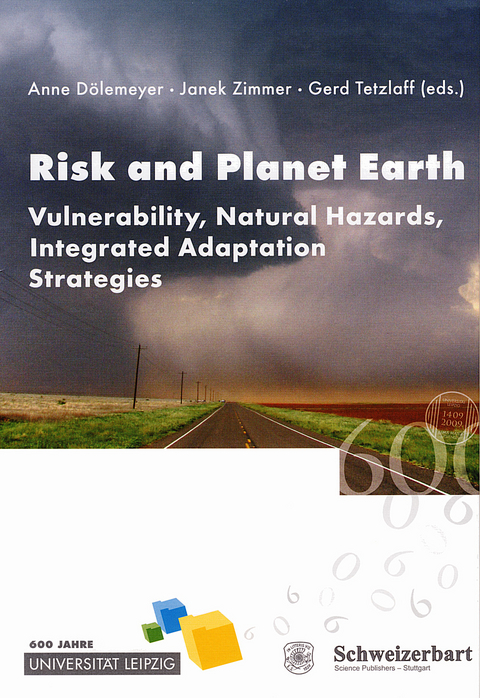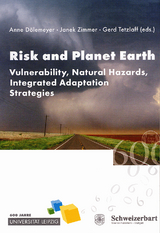Risk and Planet Earth
Vulnerability, Natural Hazards, Integrated Adaptation Strategies
Seiten
2010
Schweizerbart'sche, E. (Verlag)
978-3-510-65260-0 (ISBN)
Schweizerbart'sche, E. (Verlag)
978-3-510-65260-0 (ISBN)
Disasters are a major challenge for countries across the globe. Current debates on climate change focus both on extreme weather events that trigger disasters and their long-term variability. Effective disaster prevention requires detailed understanding of and learning from past disasters and the implementation of adaptation strategies in order to mitigate or control disasters resulting from climatic changes already under way. Among them, flood-, hurricane-, heavy rain- and drought-related disasters take a prominent place. Disaster prevention and preventive adaptation strategies present a complex challenge. Predicting climatic changes is not enough: we need scenarios that describe the probable effects of these changes on local climates and sea levels. Just as important is the implementation of technical and organizational changes in order to prevent, or at least mitigate, the impact of disasters. These changes, obviously, must take into account complex aspects of urbanization and socio-technical development. Risk and Planet Earth addresses the complexity and the multidisciplinarity of this challenge. The authors of this collection deal with a wide range of aspects. The contributions by James K. Mitchell, Ed de Mulder, Irmgard Schwaetzer and Nico Stehr stress the role of politics in coordinating integrated adaptation strategies, focussing on different aspects each. Ed de Mulder states the need to raise awareness of present climate change dynamics and foster adaptation efforts. He sees a current window of opportunity to establish regenerative energy production and take measures to enhance a balanced human impact on earth while adapting to climatic changes already under way. Nico Stehr criticizes solely focussing on climate protection as prime political strategy in Germany. He argues that adaptation measures are necessary as a second, parallel strategy. James K. Mitchells contribution advocates a holistic approach to disaster prevention and calls for political programs reflecting such preventions. In this context, he explores the multidimensional nature of both disasters and adaptation/resilience and the resulting exigencies for cross-sectional cooperation across different functional systems on all operational levels. Irmgard Schwaetzer's paper deals with the complexity of the causes of disasters triggered by hydro-meteorological hazards, which occur in increasing numbers and intensities. She stresses the importance of interdisciplinary research, arguing, that tertiary education, currently still poorly developed, is likely to play an important role in this field. This latter aspect is developed further by Ria Hidajat who presents an account of several educational programs in Pakistan and in the Andes region to this end. Other contributions present models to quantify flood risks and their use in disaster prevention (Christian Dobler; Saqhib Ehsan et al.), as well as in multidimensional vulnerability assessments, integrating socio-economic and demographic aspects and levels of risk exposure (Alexander Fekete); highlight the effects of legal/regulatory frameworks on the practice of flood mitigation measures (Wolfgang Köck); and analyze the interaction of complex socio-ecological systems of developing countries in the context of disaster recovery and adaptive strategies (Mathias Garschagen, Jörn Birkmann). Richard Campanella demonstrates how New Orleans increased geographic exposure to risk is a result of economic considerations and technical modernization, illustrating how disasters are often the result of tightly coupled social-ecological systems which have evolved over a long time period of time. The volume thus presents an exemplary overview of the breadth of long-term adaptation strategies and applied field research, taking available climate predictions as prominent examples. Being multidisciplinary in its approach, the book addresses researchers concerned with disaster prevention, interested in transcending their own disciplinary boundaries as well as practitioners in the field and the general public.
| Erscheint lt. Verlag | 15.2.2010 |
|---|---|
| Sprache | englisch |
| Maße | 170 x 240 mm |
| Gewicht | 410 g |
| Einbandart | gebunden |
| Themenwelt | Naturwissenschaften ► Geowissenschaften ► Geologie |
| Schlagworte | Emergency • Hardcover, Softcover / Geowissenschaften/Geologie • natural disaster • Naturkatastrophen • Policy |
| ISBN-10 | 3-510-65260-6 / 3510652606 |
| ISBN-13 | 978-3-510-65260-0 / 9783510652600 |
| Zustand | Neuware |
| Haben Sie eine Frage zum Produkt? |
Mehr entdecken
aus dem Bereich
aus dem Bereich




